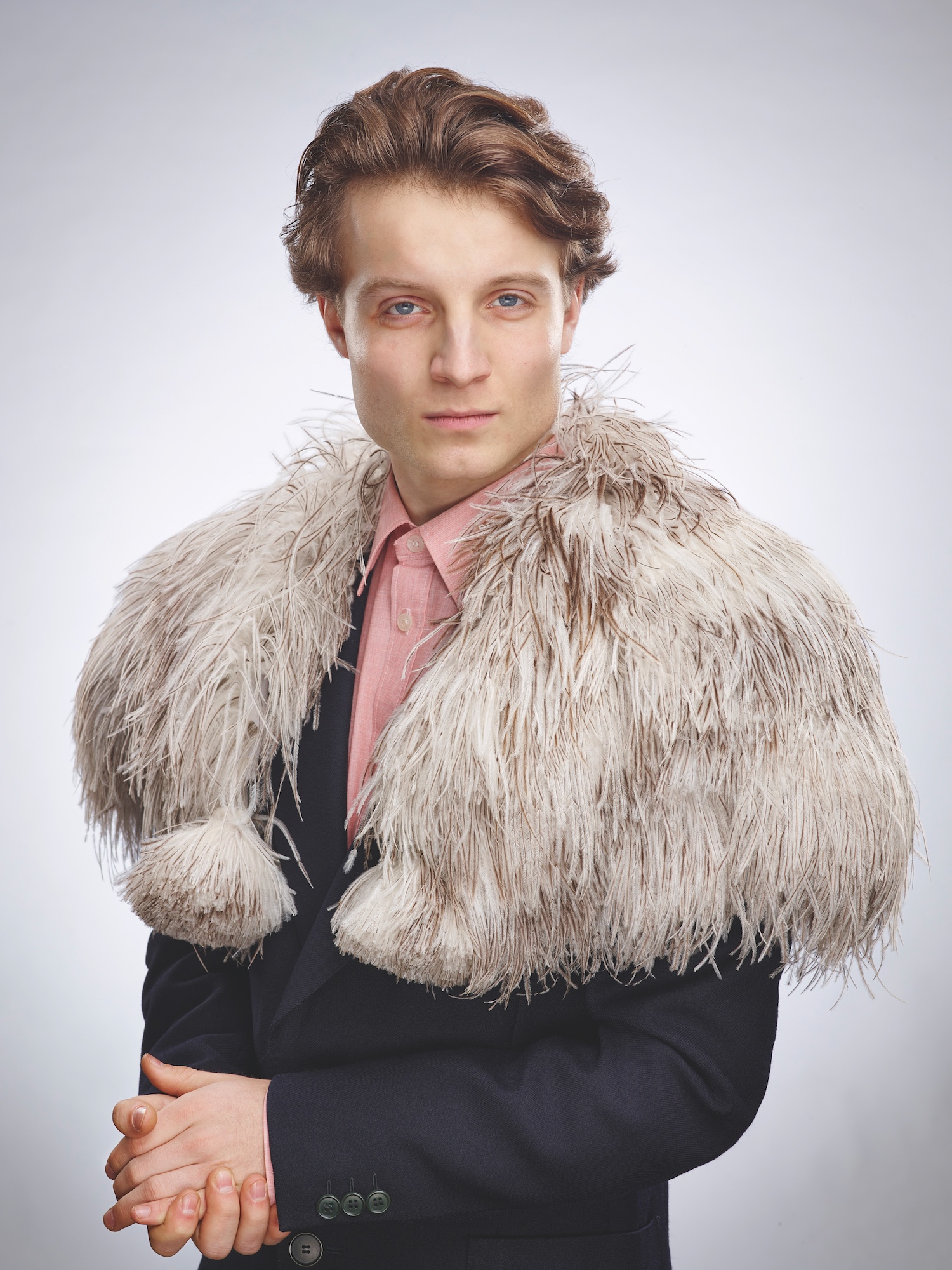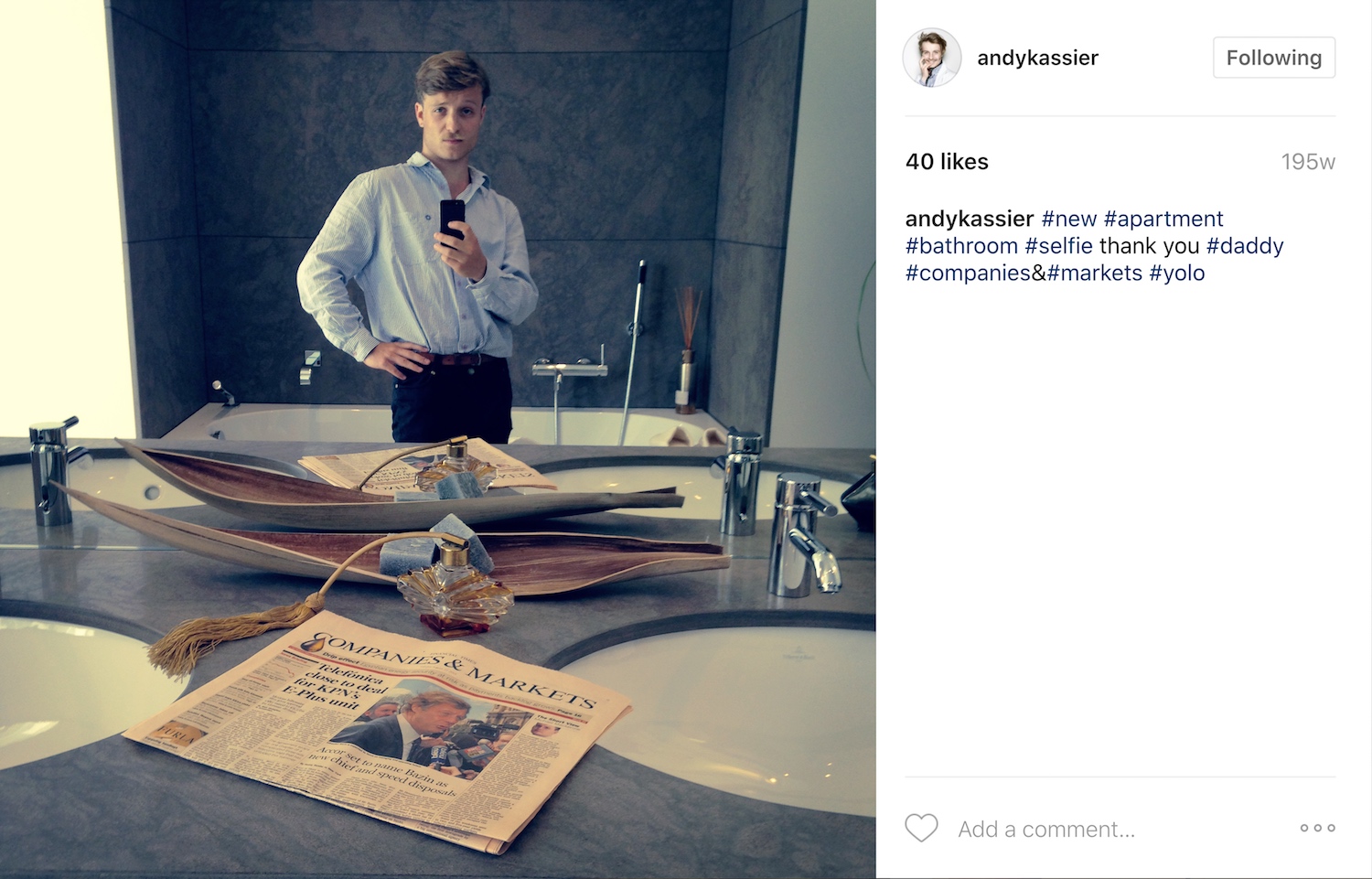
A quick flick through Instagram will confirm that selfie culture is dominated by women. Kassier’s work enters the unexplored territory of the “male selfie”, showing how and why men photograph themselves, and how this often stands in contrast to the way women depict themselves. Men, it nonetheless turns out, may be just as susceptible to the pressure to be perfect as women.
I meet the twenty-seven-year-old German artist—who turns up dressed exactly as he appears in his works, perfectly groomed, immaculate blazer—to find out more about masculinity, perfection and the man selfie.
How do you deal with perfection in your work?
In my work perfection manifests itself in the imitation of a glossy, shiny world, where of course I also leave my own mark. Perfection always represents the surface—and that is kind of what I am working against. I mean, in many ways I do not represent the perfectionist view but rather the hedonistic, where the highest good is pleasure, not any moral end or development of one’s nature.
However, in my work I do try to question that notion and its expressions. I am interested in this surface, but I want to know what stands behind it. In my mind, trying to be perfect is always an indication that someone is trying to hide something. It’s a sort of clue to a nasty backstory trying to be covered by a smiling façade.

Crystal Rocks, 2015
You hint at the façade in your work, with an apparently “perfect” image giving a glimpse of the gap between reality and representation.
I think it’s really important for me to always have a slight moment in the pictures that breaks the perfectness. I am interested in what’s behind it and how easy it is to show perfection in the first moments when you see this type of image. If you take the time you will realize that something is not 100 per cent perfect and that there is an element that kind of deconstructs the images and which lets you imagine that something is behind this. That this is not authentic.
“In my mind, trying to be perfect is always an indication that someone is trying to hide something”
Is it possible to “be real” on social media?
Instagram Stories were an attempt to bring realness to the app, but we regard normal people as ones who don’t really know how to use it because they just show their normal, seemingly boring lives—which is actually great and even better than then the manufactured Instagram feeds!
But it’s not just on Instagram: I believe authenticity no longer exists as a value in our society generally. Everything is staged. This brings me back to my work, where I show how easy it is to stage everything. I reflect what’s actually going on on social media. Personal profiles are used as business accounts.
Maybe the perfect man is the man who doesn’t try to be perfect and is just happy with his mediocrity, or with where he sees himself.

What about the male gaze in your work?
I try to create a male figure and subject it to the same gaze Laura Mulvey
described. I am not claiming that men are in fact subjected to it or that I in any way suffer from any blatant oppression, but I use this method to try and understand my personal role as well as my role as a cis male in society.
But, you know, it’s not all politics. I am drawn to Eighties advertising looks because they were fun and they allowed manliness to be pretty and over the top.
You parody many modern clichés of perfect masculinity in your work, especially the “city boy” type of man.
I reflect on the male roles seen in business and advertising: men are always strong and represent success in a kind of untouchable way. The representation of masculinity on Instagram focuses on strength and power, using every possible cliché: working out, doing business, sports cars, women (who in this work are deliberately considered as objects), partying. It is definitely about exaggerating pre-existing notions of masculinity and stretching them as far as the particular picture allows it.
“I reflect what’s actually going on on social media. Personal profiles are used as business accounts”
I don’t try and ridicule these notions and manly figures. I mean, where would that get us, right? But in our day and age these understandings of manhood are the predominant ones (Donald Trump is President—that says it all) and I try to reflect on them, sometimes more ironically than at other times but mostly just question how they came to be and why and how do we maintain them as the highest form of male.

It’s rare to see men depict themselves in the way you do. Do you think men are affected by the pressure to be perfect?
Is it rare, though? Just scroll through Tinder. I absolutely think that they are pressured to be perfect and that there is an ideal form of manhood they aspire to, both aesthetically and in terms of social behaviour and values. Being perfect in this case means not being outstanding or different. They are pressed into roles, and everything that’s different is weird and not accepted as male. Just like with women; the only difference maybe is the sorts of role. So being perfect is not about being gentle or beautiful, as it is with women. It’s more about the representation of whatever and showing power.
It is a different and less demanding form of perfection, but nonetheless there is pressure. I think it’s the thing that keeps us oppressed in capitalistic society and within ourselves, making us feel constantly inadequate. Or maybe being perfect is just to not stand out at all, so no one will recognize any difference in the matrix. Perfection is the new mediocrity.
All images courtesy and © the artist
This interview originally appeared in issue 32
BUY NOW





